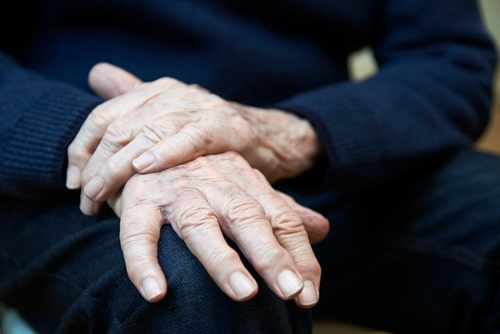The Parkinson’s Care Playbook
Parkinson’s Disease introduces a unique challenge into the lives of so many, including patients, their families, and even caregivers.
Common symptoms can make your loved one’s daily routine more difficult than ever, but a targeted treatment plan can stave off serious developments and increase a patient’s independence for years to come.
To help you navigate the world of personalized Parkinson’s Disease treatment, we’ve gathered these resources to get you started!
Table of Contents
In-Home Parkinson’s Care Guide
What is Parkinson’s Disease?
Parkinson’s Disease is a progressive nervous system disorder that usually manifests in a loss of movement and dexterity.
While there is a wide range of symptoms and treatments available, most cases start with identifiable muscle stiffness, slowness, or slightly noticeable muscle tremors. Later developments of the disease can limit speech and remove the ability to create facial expressions.
Even though Parkinson’s has no cure, several treatment options have been shown to exponentially improve symptoms and quality of life.
If you or a loved one have been recently diagnosed with Parkinson’s Disease, it is best to approach this new challenge with optimism and take early steps to educate yourself on the disease. Please consult with your doctor to determine the best treatment plan for you!
To learn more about how to handle living with Parkinson’s Disease, consult our blog with tips on managing your daily life!
Is Parkinson’s Disease hereditary?
Parkinson’s Disease is rarely inherited, although some patients are at a higher risk through the passing of faulty genes.
On a larger scale, the risk of developing Parkinson’s Disease is extremely low, with approximately 1 in 500 people above the age of 60 experiencing symptoms. However, if a first-degree family member has Parkinson’s, your risk level does increase to around 3%.
While genetic factors are largely responsible for the development of Parkinson’s, it has been determined that a more complex web of genetic code and environmental factors leads to the onset of the disease rather than purely family-based contraction.
Symptoms and Early Warning Signs
Symptoms for Parkinson’s vary greatly and may go unnoticed for years before progressing to a more severe form, but watching out for some common signs may lead to a better diagnosis.
To catch this condition early, stay on the lookout for some of these early signs:
- Tremors – This is one of the most recognizable signs of Parkinson’s and will generally form as a small shaking motion in the arms, hands, legs, or jaw.
- Mobility Issues – Muscle or joint stiffness that results in a limited range of motion can be an early sign of Parkinson’s Disease. You should consult your doctor if this stiffness does not go away after long periods of movement.
- Poor Posture – Are you hunched over or having trouble standing straight? If you are stooping, leaning, or hunching over more than usual, then it may be time to consult your doctor. Other factors like previous injury and bone issues can also contribute to this symptom as well, so exercise good judgment on what may or may not be a preexisting condition.
- Dizziness – If you are experiencing a dizzy or fuzzy feeling when standing up, you could be at risk of Parkinson’s. Thankfully, there are more common issues, like iron deficiency, that can also contribute to this condition. Consult your doctor to determine the best treatment for you!
- Trouble Sleeping – It’s normal to have the occasional night of “tossing and turning” but Parkinson’s patients can suffer more severe sleep issues. If you or your partner have noticed more sudden, thrashing movement in bed, then it may be time to connect with your doctor.
- Facial Masking – Have you been told recently that you have an expressionless or depressed look on your face? Parkinson’s Disease can affect the mobility of your facial muscles, so please reach out to your doctor if you are experiencing a loss of facial movement.
- Soft, Low Speaking Voice – Parkinson’s patients can also experience changes to their voices. If you have been told that you sound quiet or hoarse, then you should discuss your risk of Parkinson’s with your doctor.
How long can you live with Parkinson’s?
Unlike other degenerative issues, Parkinson’s Disease can have a long prognosis when caught early.
On average, patients who develop Parkinson’s around the age of 60 will live between 10 and 20 years after being diagnosed. Of course, a patient’s age and general health can also affect this estimate.
It is important to remember that Parkinson’s is not considered a fatal condition, but can make a patient more prone to fatal injuries or illnesses. Staying on top of your health and well-being in conjunction with treating your PD symptoms can help mitigate progressive symptoms for as long as possible.
How do I care for a Parkinson’s patient?
The best ways to care for your loved one, especially in the middle stages of the disease, center around assistance and increasing independence.
Here are some common ways you can help care for the Parkinson’s patient in your life:
- Bathing, Dressing, and Grooming – As mobility and dexterity start to decline, your loved one may need more assistance with some of their daily hygiene routines. Selecting easy-to-use bathing and grooming tools, as well as elastic clothing, can not only speed up some of these activities but increase the patient’s independence as well.
- Housekeeping and Laundry – Parkinson’s Disease may lead to a general decrease in energy levels or fatigue, so taking care of these more laborious tasks can go a long way!
- Stretching and Mild Exercise – Your loved one’s joints and muscles may tense up over time. Encouraging and joining them in some physician-recommended exercises or stretches can help keep them limber.
- Medication Reminders – As Parkinson’s progresses to the later stages, it is not uncommon to experience some cognitive issues. Helping your patients stay on top of their medication can better ensure the doctor-provided care plan is better adhered to.
- Running Basic Errands – There may come a time when it is difficult for seniors to make it out of the house on their own. Stepping in to either assist or entirely run errands for them can be a great time saver and bring more peace of mind into your home!
Having difficulties providing this care yourself? There are several options for in-home care providers. Westchester Family Care specializes in providing top-notch in-home caregivers in the greater New York area.
If you are not in the area, please reach out to your doctor for suggestions on a qualified caregiver near you!
At-home Parkinson’s Treatments
Because not all Parkinson’s symptoms require full-time monitoring, a large majority of time spent managing the symptoms of Parkinson’s disease can occur in the home.
Even though there is not an available home remedy for Parkinson’s, making the most of this time you have can go a long way towards increasing the happiness and independence of your loved one.
One of the best ways to stay on top of Parkinson’s symptoms is to stay on top of the recommended treatment.
While this may seem like a simple or even obvious task at first, more intense plans can feel burdensome at times. Following through with prescriptions for antidepressants, cognitive-enhancing medications, or even anti-tremor medications can go a long way in improving the very symptoms they’re intended to treat.
Additionally, following through with self-care like exercise, diet, and lifestyle changes can improve the overall quality of life that your patient can experience. Before taking any of these steps, it is still best to discuss your home care plan with your healthcare provider to better determine the right direction for you!
Diet and Nutrition
While there may not be a specific diet available for Parkinson’s Disease, maintaining a strong and balanced diet in conjunction with your treatment plan can help support senior health in the long term.
When making serious, long-term diet choices, you should always consult your doctor or dietitian to make sure you can support these larger changes. To help get you started, here are a few key things to remember when planning your diet choices:
- Avoid Fad Diets – Making sure that you and your loved ones are consuming a wide variety of foods will ensure you are getting all the nutrients and fiber you need to maintain good health.
- Opt for Veggies and Complex Grains – Introducing a range of healthy food groups into a diet brings better long-term sources for various nutrients, complex carbohydrates, and healthy fiber.
- Incorporate “Brain Food” – Food sources that are high in antioxidants have been shown to better improve brain function over time. While this is in no way a cure, it can help improve the long-term outlook for any patient!
- Choose Low-Fat Foods – Cutting unhealthy fats from processed foods out of your diet can improve heart health and overall energy levels, as well as lessening the risk of more serious conditions like diabetes and cancer. Even though this may not directly fight PD, staying healthy during the long lifespan of the condition can improve a patient’s overall quality of life greatly!
For more information on supporting a strong and healthy diet, please read our blog on preventing senior malnutrition!
Lifestyle and Exercise
Making valuable lifestyle changes will not only help you manage Parkinson’s symptoms but will also assist in improving the overall quality of life that you or your loved one enjoys.
While no single lifestyle change can act as a cure-all, the positive benefits of taking some of the following steps can dramatically improve your situation:
- Get Enough Sleep – Sleeping a full 8 hours each night allows your body to completely rest and recover from the strains of the previous day. As symptoms progress and daily activities become more cumbersome, it may also be advisable to take 1 or 2 naps when needed. Failing to get enough sleep can worsen your symptoms and lead to increased fatigue going forward.
- Eat Healthily – As mentioned in the previous section, a proper diet can help prevent a wide range of serious health risks, including heart disease, diabetes, and certain cancers. Keeping your general health in order will also help prevent complications for Parkinson’s Disease, so please consult your doctor or dietitian to determine the best dietary choices for you!
- Improve Home Safety – As symptoms progress, simple hazards like in-home clutter can lead to easily avoidable injuries and falls. Making simple home improvements can ensure easy movement around the home and help protect your loved one for longer!
- Exercise Regularly – Building strength is one of the best ways to battle the growing balance and movement issues that are common with Parkinson’s patients. Getting at least 150 minutes of aerobic, strength, or balance-based exercise per week can greatly increase your movement and dexterity while also improving your overall health.
When it comes to exercise, it is important to know what you are capable of doing and when you may need help. There is no shame in seeking out a personal trainer or a rehabilitation specialist, especially if you have recently suffered an injury. Take some time to talk with a professional to evaluate your goals and the best ways to reach them!
To stay updated on the latest articles and
industry news, subscribe to our newsletter!
In-Home Parkinson’s Care Guide
Taking charge of your or your loved one’s Parkinson’s treatment plan can make years’ worth of differences in the success of the treatment. However, with a potential lifespan of over 20 years post-diagnosis, it is okay to admit that you may not be able to do it all on your own.
To help you handle one of life’s most arduous fights, we’ve gathered these resources on some of the key areas you can focus on to manage Parkinson’s Disease as it progresses.
Physical Therapy and Rehabilitation

Parkinson’s patients can suffer serious hindrances to their dexterity, strength, and movement as the disease progresses. While combatting these symptoms with medication is always helpful, it is important to continually build or maintain strength wherever possible.
This is especially important when returning from an injury, as the added stress of movement during recovery could exacerbate some PD symptoms.
Enrolling in a rehabilitation program or inpatient facility following an injury can be a game-changer in terms of post-hospitalization success. The more intensive and well-monitored exercise programs administered through these facilities can quickly improve the physical state of some patients and can set the stage for greater long-term recovery.
For more information on the benefits of short-term rehabilitation, please continue reading in this article on the Value of Short Term Rehabilitation!
If you have not been injured but still have some issues handling exercises on your own, it may be time to consider a form of therapy instead. These methods include, but are not limited to:
- Physical Therapy
- Occupational Therapy
- Music Therapy
- Art Therapy
All of these methods will include some form of controlled, communal, or supervised exercise for the mind and body to better ensure that each is performing at its peak potential.
Other class-based exercises, like Tai Chi, Water Aerobics, and Yoga can also be helpful, but it is still best to discuss your treatment plan with a qualified healthcare professional.
If you are looking to get started right away, Westchester Family Care has prepared a 10-week exercise program for Parkinson’s patients. Click below to read or download it now!
Fall Prevention

As Parkinson’s causes issues like muscle twitching and freezing, common clutter and messes around the house can pose a serious fall risk.
Falls are by far the most common injury for senior citizens and can lead to complications, difficult recovery, or even death. Taking proactive steps throughout the life of the disease can improve the long-term comfort and independence of each patient.
A majority of these falls occur in the busier areas of the home, like kitchens, dining rooms, and bedrooms. Protecting your loved one in these more difficult areas is key to reducing serious fall risks in the home.
Here are some simple recommendations from our care team to improve the in-home care environment and make your home a safer place for seniors:
- Remove home hazards: Sharp corners, extremely hard surfaces, slick carpeting, and other materials can pose a great slipping risk for seniors. Adding protection, padding, or even removing some of these items can go a long way towards making your home safer.
- Improve your lighting: Stepping up the brightness of your current fixtures or adding additional lighting in difficult places will help you avoid the pitfalls in your home. Difficult places, like rails and stairs, can become much easier to navigate with better visibility. Simply moving to higher wattage bulbs will bring more light to your home and is a relatively cheap way to improve the safety of your home.
- Wear supportive footwear: Steady footing is a key player in maintaining high mobility. When combined with assistive devices, you’ll be on your way to safe and stable travel!
- Use assistive devices (canes, walkers, etc.): Assistive devices bring stability to your daily life by adding extra points of contact between you and the ground. Additionally, installing rails along walls or stairways will serve the same purpose in more strenuous areas of the home. The best part is that assistive devices can be taken out of the home, making even the most rugged terrain more accessible.
For more information on how you can improve your in-home environment and increase the overall independence of your loved one, check out our comprehensive Fall Prevention and Home Safety Guide!
Medication Adherence

Your treatment plan is specially designed for your success, and this includes the medication you are prescribed.
The dangers of not following your treatment and medication plan can include progressed symptoms and further complications from your disease. This is compounded by the long-term prognosis of diseases like Parkinson’s where treatment is centered around combatting and managing symptoms for as long as possible.
Medication Adherence is the practice of correctly following your physician’s medical advice or prescription instructions. Also known as patient compliance, it is a crucial step in ensuring long-term health and well-being.
While the process of strictly following your treatment plan can seem tedious at times, it is a proven method to help produce the best results. Please read more about this topic in our article on the dangers of medication non-adherence.
In-Home Care and Assistance

Finally, as Parkinson’s symptoms progress, it will become increasingly difficult to remain independent. Starting the transition early with an in-home caregiver or assistant can make life easier for both the patient and their family, all while increasing the overall level of care and independence of the patient.
One of the largest benefits of in-home care is the customizable nature of the treatment. Most agencies have services that can be tailor-fit to the needs of you or your loved ones.
For example, you may only need some minor assistance to start, like help with groceries or transportation to and from therapy appointments, but your care can scale with you as symptoms progress. When movement becomes more difficult and chores become more of a burden, having a live-in caregiver can bring great value to the patient while relieving some of the burdens off of the family.
Thankfully, Westchester Family Care can make even the most intense treatment seem like a breeze. For more information, read our 5 Easy Steps for Recovery with In-Home Care here!
Parkinson’s Care Patient Stories

Anthony N.
WFC recently lost one of our “greatest” clients – Anthony N. truly personified the World War II veterans for whom Tom Brokaw coined the term our “Greatest Generation.”
In-Home Parkinson’s Care with Westchester Family Care
Westchester Family Care is a full-service provider of in-home caregiving and assistance for patients of all types. We have specialized services for Parkinson’s care patients including exercise regimens, patient visits, and various levels of in-home caregivers.
Contact us today for more information on how we can help you!
